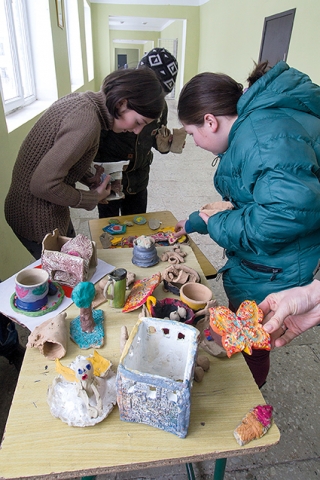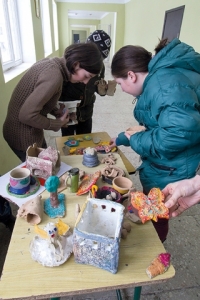Clay on Display: Etseri, Svaneti
BLOG
Every step of our local children’s education in using clay has been a reminder to me of the same processes in my own life, more than 30 years ago.
Recently, their works went on display at our school, laid out on tables and admired by fellow pupils, teachers and some parents too. Even getting the pieces from home to school took me back.
How do you pack clay work, some of it perhaps quite fragile, for transport by vehicle or on foot to its exhibition space? You line a box with crumpled and opened out paper, on which you lay the pieces, and if they are strong enough even layer them with more paper between and around. This creates a soft but protective space around them, and off you go.
We needed such knowledge, even though the school is only about three minutes’ walk from the house. It’s still quite an icy road downhill, you see, and easy to slip on. So, we packed and walked the boxes down most carefully, and then unpacked them at the other end for show.
The looks of pride on the young artists’ faces, and similarly on those of their parents, spoke volumes. They’d had no compunctions about getting their hands into the earthy raw material, about actually being allowed, encouraged even, to roll up their sleeves and go for it. Clay does wash off in water, after all; there’s no smell, this is “clean dirt” if it ever was. After careful drying and the bisque, or first, firing, the pieces were ready to be painted with water-based pigments. We did not have the possibility to use glazes this time; these require another, higher-temperature firing which is beyond the range of my big Svan stove. But paint was fine for this introductory experience.
Hand-built and wheel-thrown vessels, flat pieces with rolled or pressed textures, coil-built sculptures, animals, even a Svan tower: all came to life as the children experimented and realized that whatever their mind could conceive was worth at least trying in clay. As long as you didn’t vary the wall thickness of your piece too much, or leave air pockets to explode during firing, you stood a good chance of seeing your handiwork emerge from the kiln changed into something which would no longer dissolve in water back to its primeval form.
I never got a chance this time to use the wheel myself; but I’ll visit its owner in Mtskheta soon and have a go at this medium which I love. My head is still full of other ideas which I’ll leave with her as well. Throwing a lump around on a canvas-covered table until is slowly dries and gets a naturally cracked surface. Using a stretched spring, instead of the usual ordinary string, to cut through raw clay, resulting in a fantastically wavy-textured cut. Repeatedly dipping a clay core into alternating liquid slips of white and blue clay, say, building it up from them; then cutting through this with string to reveal all those contrasting striped layers.
There’s even clay in them there hills, here in Svaneti! It has been known about and used for centuries, if not millennia. Perhaps this should be no surprise, for such an ancient country as Georgia. The surprise will come, however, with the new forms still waiting to slip from dream into reality. Then we’ll really see something.
Tony Hanmer has lived in Georgia since 1999, in Svaneti since 2007, and been a weekly writer for GT since early 2011. He runs the “Svaneti Renaissance” Facebook group, now with nearly 2000 members, at www.facebook.com/groups/SvanetiRenaissance/
He and his wife also run their own guest house in Etseri:
www.facebook.com/hanmer.house.svaneti
By Tony Hanmer












